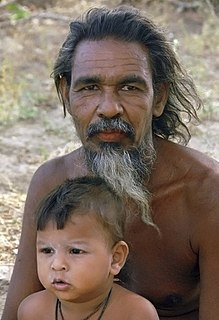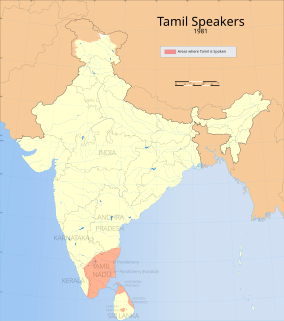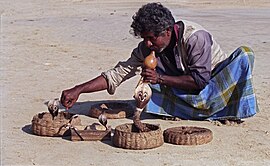
This article is about the demographic features of the population of Sri Lanka, including population density, ethnicity, education level, health of the populace, economic status, religious affiliations and other aspects of the population.

Sinhalese people, are an Indo-Aryan ethnic group of the island of Sri Lanka. They were historically known as Hela people, Ceylonese islanders, and Sinhalese islanders. They constitute about 75% of the Sri Lankan population and number greater than 16.2 million. The Sinhalese identity is based on language, cultural heritage and nationality. The Sinhalese people speak Sinhala, an insular Indo-Aryan language, and are predominantly Theravada Buddhists, although a minority of Sinhalese follow branches of Christianity and other religions. Since 1815, they were broadly divided into two respective groups: The 'Up-country Sinhalese' in the central mountainous regions, and the 'Low-country Sinhalese' in the coastal regions; although both groups speak the same language, they are distinguished as they observe different cultural customs. According to the Mahavamsa and the Dipavamsa, a 3rd–5th century treatise written in Pali by Buddhist monks of the Anuradhapura Maha Viharaya in Sri Lanka, the Sinhalese descend from the Indo-Aryan settlers who came to the island in 543 BCE from Sinhapura, in India, led by Prince Vijaya.

The Vedda, or Wanniyalaeto, are a minority indigenous group of people in Sri Lanka who, among other sub-communities such as Coast Veddas, Anuradhapura Veddas and Bintenne Veddas, are accorded indigenous status. The Vedda minority in Sri Lanka may become completely assimilated. Most speak Sinhala instead of their indigenous languages, which are nearing extinction. It has been hypothesized that the Vedda were probably the earliest inhabitants of Sri Lanka and have lived on the island since before the arrival of other ethnic groups in India.

Islam in Sri Lanka existed in communities along the Arab coastal trade routes in Ceylon as soon as the religion originated and had gained early acceptance in the Arabian Peninsula. In the 16th century, descendants of Arab traders' were the main traders in spice, with networks extending to the Middle East, are now called the Sri Lankan Moors. About 1,967,227 persons adhere to Islam as per the census of 2012. Islam is a minority religion in Sri Lanka with 9.7% of the Sri Lankan population practice Islam.
Sri Lankan Australians refers to people of Sri Lankan heritage living in Australia; this includes Sri Lankans by birth and by ancestry. Sri Lankan Australians constitute one of the largest groups of Overseas Sri Lankan communities and are the largest diasporic Sri Lankan community in Oceania. Sri Lankan Australians consist of people with Sinhalese, Tamil, Moor, Burgher, Malay and Chinese origins among others.

The Tamil diaspora refers to descendants of the Tamil immigrants who emigrated from their native lands to other parts of the world. They are found primarily in Malaysia, Myanmar, South Africa, Singapore, Arab states of the Persian Gulf, North America, Oceania and Western Europe.
The Portuguese Burghers are an ethnic group in Sri Lanka, of mixed Portuguese and Sri Lankan descent. They are Roman Catholic and spoke the Sri Lanka Indo-Portuguese language, a creole based on Portuguese. In modern times, English has become the common language while Sinhalese is taught in school as a second language. Many Portuguese Burghers living on the east coast of Sri Lanka are of Portuguese descent; this is evident in the Sri Lanka-Indo Portuguese language, which has many affiliations to Sinhalese and Portuguese. They are mixed with other Burgher people, including Dutch Burghers. However, Portuguese Burghers are not Dutch Burghers.

Sri Lankan Tamils, also known as Ceylon Tamils or Eelam Tamils, are members of the Tamil ethnic group native to the South Asian island state of Sri Lanka. Today, they constitute a majority in the Northern Province, live in significant numbers in the Eastern Province and are in the minority throughout the rest of the country. 70% of Sri Lankan Tamils in Sri Lanka live in the Northern and Eastern provinces.
Bharatha People also known as Bharatakula and Paravar, is an ethnicity in the island of Sri Lanka. Earlier considered a caste of the Sri Lankan Tamils, they got classified as separate ethnic group in the 2001 census. They are descendant of Tamil speaking Paravar of Southern India who migrated to Sri Lanka under Portuguese rule. They live mainly on the western coast of Sri Lanka and mainly found in the cities of Mannar, Negombo and Colombo.
Negombo Tamils or Puttalam Tamils are the native Sri Lankan Tamils who live in the western Gampaha and Puttalam districts of Sri Lanka. They are distinguished from other Tamils from the island nation by their unique dialects, one of which is known as Negombo Tamil dialect. Other sub categories of native Tamils of Sri Lanka are Jaffna Tamils or Northern Tamils and Batticalao Tamils or Eastern Tamils from the traditional Tamil dominant North and East of the Island nation. Negombo is a principal coastal city in the Gampaha District and Puttalam is also the principal city within the neighbouring Puttalam District.
South Asian ethnic groups are an ethnolinguistic grouping of the diverse populations of South Asia, including the nations of Afghanistan, India, Pakistan, Bangladesh, Nepal, Bhutan, the Maldives and Sri Lanka. Afghanistan, which is usually considered to be in Central Asia, is sometimes grouped with South Asia, but Afghans are generally not included among South Asian ethnic groups.

Sri Lankan Moors are an ethnic minority group in Sri Lanka, comprising 9.2% of the country's total population. Most of them are native speakers of the Tamil language who also speak Sinhalese as a second language. They are predominantly followers of Islam. The Sri Lankan Muslim community is divided as Sri Lankan Moors, Indian Moors and Sri Lankan Malays as per their history and traditions.
Sri Lankan state-sponsored colonization schemes is the government program of settling mostly farmers from the densely populated wet zone in the sparsely populated areas of the dry zone in the North Central Province, Southern Province, Uva Province, Sabaragamuwa Province, Northern Province and the Eastern Province regions near tanks and reservoirs being built in major irrigation and hydro-power programs such as the Mahaweli project to create farming and fishing communities. This has taken place since the 1950s.
The origins of the Sri Lankan Civil War lie in the continuous political rancor between the majority Sinhalese and the minority Sri Lankan Tamils. Before and during the early part of colonial rule by Europeans, Sri Lanka was under the rule of three separate kingdoms. During the colonial rule by Portuguese and then the Dutch, the three sovereign states were ruled as separate entities. The final British colonial rule amalgamated the entire island into a single administrative entity after independence, and the minorities were handed over to the mercy of the majority. According to Jonathan Spencer, a social anthropologist from the School of Social and Political Studies of the University of Edinburgh, the war is an outcome of how modern ethnic identities have been made and re-made since the colonial period, with the political struggle between minority Tamils and the Sinhalese-dominant government accompanied by rhetorical wars over archeological sites and place name etymologies, and the political use of the national past.

The 1956 anti-Tamil pogrom, also known as the Gal Oya riots, was the first organised pogrom against Sri Lankan Tamils in the Dominion of Ceylon. It began with anti-Tamil rioting in Colombo, followed by anti-Sinhalese rioting in Batticaloa. The worst of the violence took place in the Gal Oya valley, where local majority Sinhalese colonists and employees of the Gal Oya Development Board commandeered government vehicles, dynamite and weapons and massacred minority Tamils. It is estimated that over 150 people lost their lives during the violence. The police and army were eventually able to bring the situation under control.

Sri Lankan Malays (Sinhala: මැලේ ජනතාව ; මැලේ මිනිස්සු / ජා මිනිස්සු ; Tamil: இலங்கை மலாய் மக்கள், romanized: Ilaṅkai Malāi Makkal are Sri Lankans with full or partial ancestry from the Indonesian Archipelago, Malaysia, or Singapore. The term is a misnomer as it is used as a historical catch-all term for all native ethnic groups of the Malay Archipelago who reside in Sri Lanka; the term does not apply solely to the ethnic Malays. They number approximately 40,000 and make up 0.2% of the Sri Lankan population, making them the fourth largest of the five main ethnic groups in the country.

The Coast Veddas, by self-designation, form a social group within the minority Sri Lankan Tamil ethnic group of the Eastern province of Sri Lanka. They are primarily found in small coastal villages from the eastern township of Trincomalee to Batticalao. Nevertheless, they also inhabit a few villages south of Batticalao as well. They make a living by fishing, slash and burn agriculture, paddy cultivation of rice, basket weaving for market and occasional wage labor. Anthropologists consider them to be partly descended from the indigenous Vedda people, as well as local Tamils. Residents of the Eastern province consider their Vedar neighbors to have been part of the local social structure from earliest times, whereas some Vedar elders believe that their ancestors may have migrated from the interior at some time in the past.
Indians in Sri Lanka refer to Indians or people of Indian ancestry living in Sri Lanka, such as the Indian Tamils of Sri Lanka.

Tamil settlement of Sri Lanka refers to the settlement of Tamils, or other Dravidian peoples, from Southern India to Sri Lanka. Due to Sri Lanka's close proximity to Southern India, Dravidian influence on Sri Lanka has been very active since the early iron age or megalithic period.

The South Indian diaspora (Telugu: దక్షిణ భారత డయాస్పోరా) comprises people who have emigrated from South Indian states to other Indian states and other countries, and people of South Indian descent born or residing in other Indian stats and other countries.










